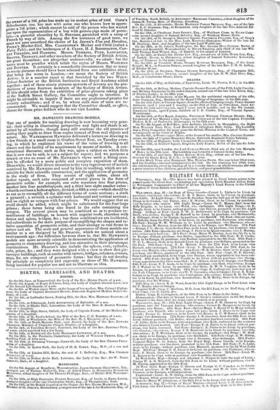MR. HAWKINS'S DRAWING - MODELS.
THE use of models for teaching drawing is now becoming very gene- ral: their utility in illustrating perspective and light and shade is ad- mitted by all teachers ; though many still continue the old practice of setting their pupils to draw from copies instead of from real objects and nature. Mr. WATERHOUSE Hewenis delivered a lecture on drawing to a few friends at a small room in Grafton Street East, on Tuesday even- ing, in which he explained his views of the value of drawing to all classes and the facility of its acquirement by means of models. A con- versational discourse, such as this was, upon a subject on which little that is new can be said, is not a subject for report ; and we postpone a remark or two on some of Mr. HAWKINS'S views until a fitting occa- sion be afforded by a more public and complete exposition of them. Meanwhile, we would direct attention to the very ingenious set of models contrived by Mr. HAWKINs and used by him in teaching, which are ad- mirable for their scientific construction, and the application of geometry to the study of form. They consist of eight cubes, about six inches square, each cube composed of several pieces in the form of geometric solids : for example, one cube separates into four prisms, another into four parallelopipeds, and a third into eight smaller cubes : a fourth encloses a hollow-sphere divided; a fifth a cone—which should be so cut as to exemplify all the different forms of conic sections ; a sixth a pyramid ; a seventh a cylinder with horizontal and vertical Sections; and an eighth an octagon with four prisms. We would suggest that an ovoid should be added, which might be substituted for the four large prisms ; these forms being also found in the cube containing the octagon. The several pieces may be combined so as to produce re- semblances of buildings, as houses with angular roofs, churches with domes and spires, bridges, &c. ; but these combinations are incidental, and subordinate to the main purpose of exemplifying the shapes and re- lative quantities of geometric solids, and their analogy to real forms in nature and art. The scale and general appearance of these models are similar to a set designed by Mr. DEACON, which we noticed about a twelvemonth ago : the difference between them is, that Mr. HAWKINS'S models are more severely scientific in demonstrating the application of geometry to elementary drawing, and less attractive in their picturesque combinations. Mr. DEACON'S also include the sphere, cone, cylinder, cube, prism, &c.; and they were designed with a view to show that pic- turesque buildings, such as castles with turrets, bridges, columns, crosses, steps, arc. are composed of geometric forms : but they do not develop the principle so completely and expressly as those of Mr. HAWKINS, being intended for popular use and not to illustrate an idea.


























 Previous page
Previous page